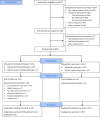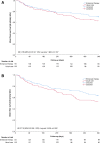Effectiveness of at-home skin temperature monitoring in reducing the incidence of foot ulcer recurrence in people with diabetes: a multicenter randomized controlled trial (DIATEMP)
- PMID: 34493496
- PMCID: PMC8424833
- DOI: 10.1136/bmjdrc-2021-002392
Effectiveness of at-home skin temperature monitoring in reducing the incidence of foot ulcer recurrence in people with diabetes: a multicenter randomized controlled trial (DIATEMP)
Abstract
Introduction: The skin of people with diabetic foot disease is thought to heat up from ambulatory activity before it breaks down into ulceration. This allows for early recognition of imminent ulcers. We assessed whether at-home monitoring of plantar foot skin temperature can help prevent ulcer recurrence in diabetes.
Research design and methods: In this parallel-group outcome-assessor-blinded multicenter randomized controlled trial (7 hospitals, 4 podiatry practices), we randomly assigned people with diabetes, neuropathy, foot ulcer history (<4 years, n=295), or Charcot's neuro-arthropathy (n=9) to usual care (ie, podiatric treatment, education, and therapeutic footwear) or usual care plus measuring skin temperatures at 6-8 plantar sites per foot each day (enhanced therapy). If ∆T>2.2°C between corresponding sites on the left and right foot for two consecutive days, participants were instructed to reduce ambulatory activity until this hotspot disappeared and contact their podiatrist. Primary outcome was ulcer recurrence in 18 months on the plantar foot, interdigital, or medial/lateral/anterior forefoot surfaces; secondary outcome was ulcer recurrence at any foot site.
Results: On the basis of intention-to-treat, 44 of 151 (29.1%) participants in enhanced therapy and 57 of 153 (37.3%) in usual care had ulcer recurrence at a primary outcome site (RR: 0.782 (95%CI 0.566 to 1.080), p=0.133). Of the 83 participants in enhanced therapy who measured a hotspot, the 24 subsequently reducing their ambulatory activity had significantly fewer ulcer recurrences (n=3) than those in usual care (RR: 0.336 (95% CI 0.114 to 0.986), p=0.017). Enhanced therapy was effective over usual care for ulcer recurrence at any foot site (RR: 0.760 (95% CI 0.579 to 0.997), p=0.046).
Conclusions: At-home foot temperature monitoring does not significantly reduce incidence of diabetic foot ulcer recurrence at or adjacent to measurement sites over usual care, unless participants reduce ambulatory activity when hotspots are found, or when aiming to prevent ulcers at any foot site.
Trial registration number: NTR5403.
Keywords: diabetic foot; foot ulcer; prevention; self-management.
© Author(s) (or their employer(s)) 2021. Re-use permitted under CC BY-NC. No commercial re-use. See rights and permissions. Published by BMJ.
Conflict of interest statement
Competing interests: None declared.
Figures


Similar articles
-
An integrated personalized assistive devices approach to reduce the risk of foot ulcer recurrence in diabetes (DIASSIST): study protocol for a multicenter randomized controlled trial.Trials. 2023 Oct 12;24(1):663. doi: 10.1186/s13063-023-07635-z. Trials. 2023. PMID: 37828618 Free PMC article.
-
The cost-effectiveness and cost-utility of at-home infrared temperature monitoring in reducing the incidence of foot ulcer recurrence in patients with diabetes (DIATEMP): study protocol for a randomized controlled trial.Trials. 2018 Sep 24;19(1):520. doi: 10.1186/s13063-018-2890-2. Trials. 2018. PMID: 30249296 Free PMC article.
-
A pilot study testing the feasibility of skin temperature monitoring to reduce recurrent foot ulcers in patients with diabetes--a randomized controlled trial.BMC Endocr Disord. 2015 Oct 9;15:55. doi: 10.1186/s12902-015-0054-x. BMC Endocr Disord. 2015. PMID: 26452544 Free PMC article. Clinical Trial.
-
Prevention of foot ulcers in the at-risk patient with diabetes: a systematic review.Diabetes Metab Res Rev. 2020 Mar;36 Suppl 1:e3270. doi: 10.1002/dmrr.3270. Epub 2020 Jan 19. Diabetes Metab Res Rev. 2020. PMID: 31957213
-
Systematic reviews of wound care management: (3) antimicrobial agents for chronic wounds; (4) diabetic foot ulceration.Health Technol Assess. 2000;4(21):1-237. Health Technol Assess. 2000. PMID: 11074391 Review.
Cited by
-
Efficacy of at home monitoring of foot temperature for risk reduction of diabetes-related foot ulcer: A meta-analysis.Diabetes Metab Res Rev. 2022 Sep;38(6):e3549. doi: 10.1002/dmrr.3549. Epub 2022 Jun 8. Diabetes Metab Res Rev. 2022. PMID: 35605998 Free PMC article.
-
The Validity and Efficacy of a Preventative Intervention Model for Reducing Ulcer Recurrence in Diabetic Patients in Indonesia.SAGE Open Nurs. 2023 Jun 12;9:23779608231179549. doi: 10.1177/23779608231179549. eCollection 2023 Jan-Dec. SAGE Open Nurs. 2023. PMID: 37334064 Free PMC article.
-
Short-Term Efficacy of a Multi-Modal Intervention Program to Improve Custom-Made Footwear Use in People at High Risk of Diabetes-Related Foot Ulceration.J Clin Med. 2025 May 22;14(11):3635. doi: 10.3390/jcm14113635. J Clin Med. 2025. PMID: 40507403 Free PMC article.
-
Infrared Thermography Shows That a Temperature Difference of 2.2°C (4°F) or Greater Between Corresponding Sites of Neuropathic Feet Does Not Always Lead to a Diabetic Foot Ulcer.J Diabetes Sci Technol. 2024 May 6:19322968241249970. doi: 10.1177/19322968241249970. Online ahead of print. J Diabetes Sci Technol. 2024. PMID: 38708580 Free PMC article.
-
An integrated personalized assistive devices approach to reduce the risk of foot ulcer recurrence in diabetes (DIASSIST): study protocol for a multicenter randomized controlled trial.Trials. 2023 Oct 12;24(1):663. doi: 10.1186/s13063-023-07635-z. Trials. 2023. PMID: 37828618 Free PMC article.
References
Publication types
MeSH terms
Substances
LinkOut - more resources
Full Text Sources
Medical
